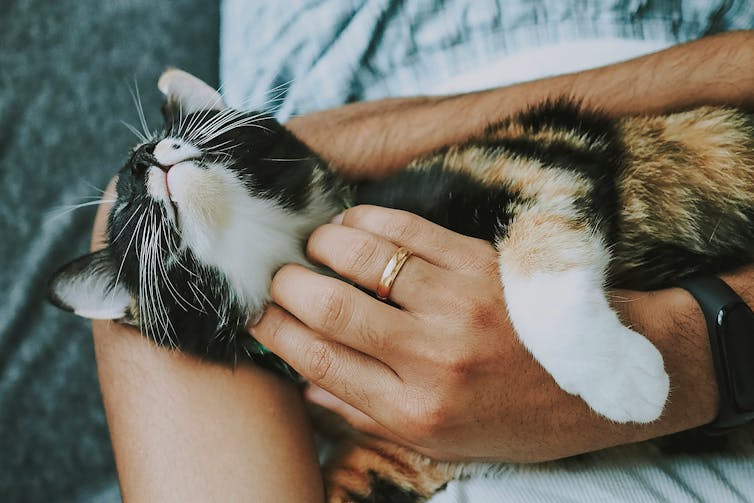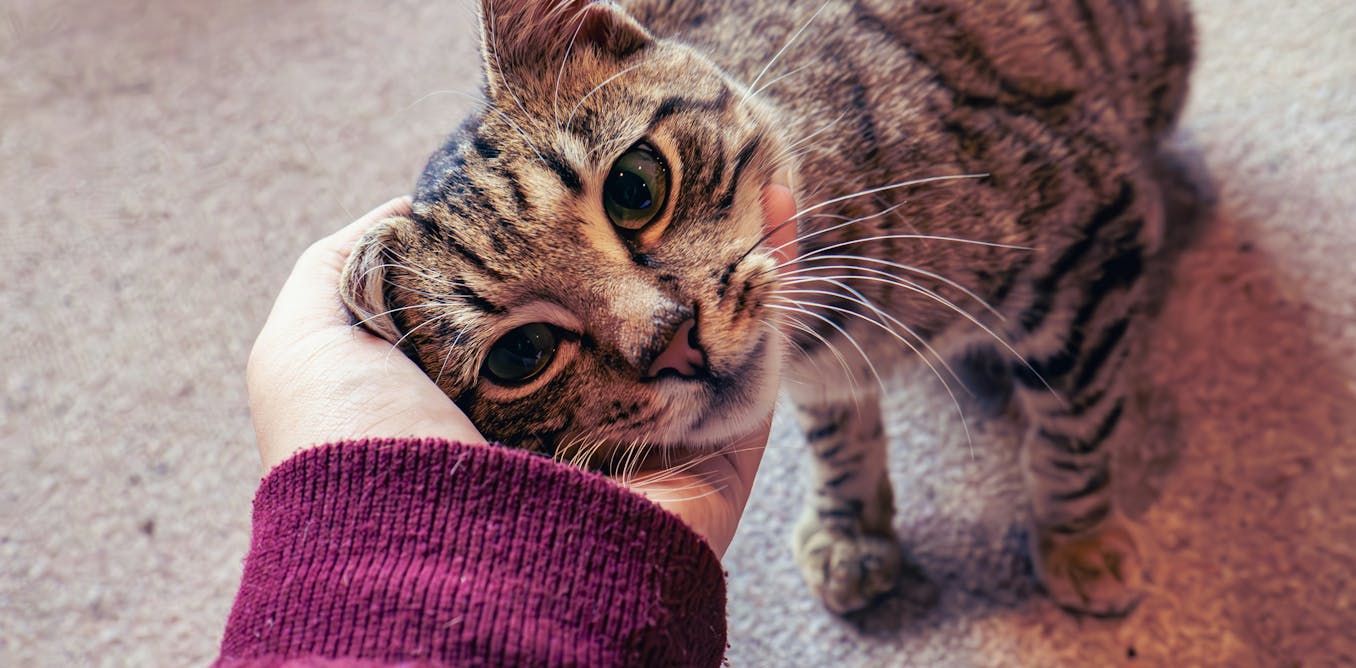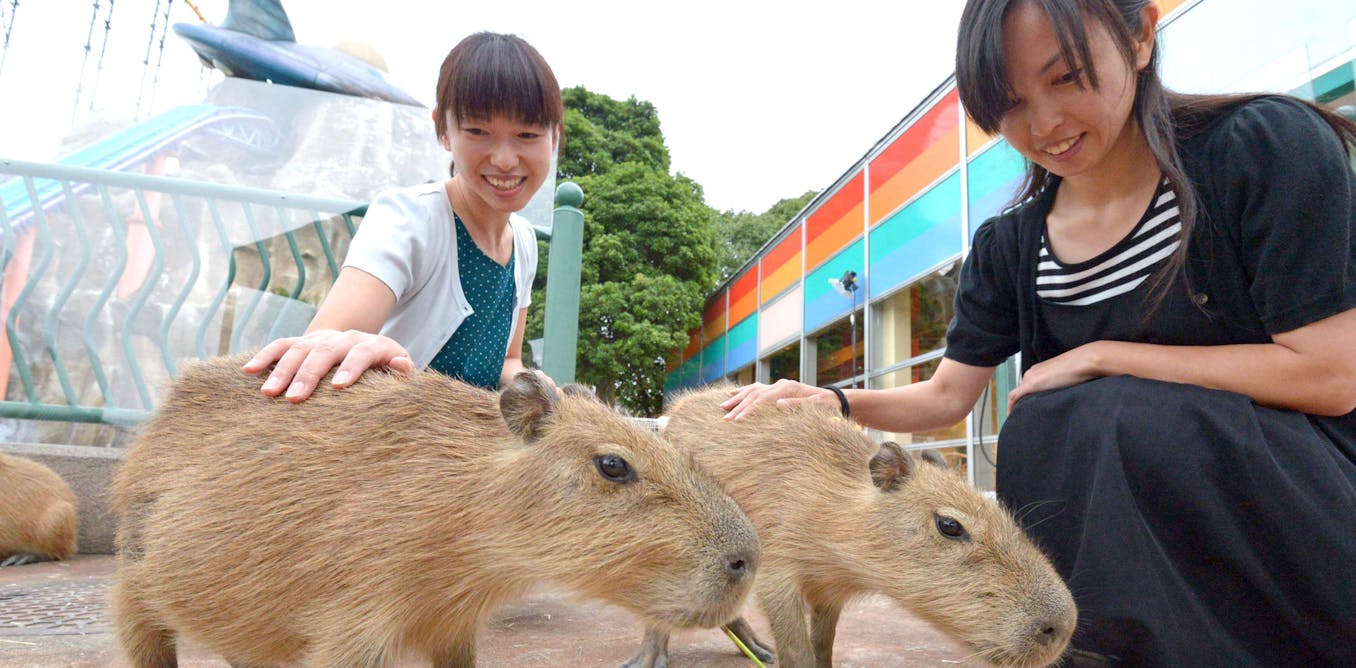While often miscast as mysterious or hard to understand, cats are actually excellent communicators. In fact, in free-ranging cat colonies, physical fights are kept to a minimum through clever use of body posturing, scent exchange and vocalisations.
Cats have also adapted their communication for humans. For instance, adult cats don’t usually meow at each other. But when around people, cats meow a lot, suggesting they have adapted this vocalisation for communicating with humans.
And it’s not just the meow. Cats have a wide vocal repertoire for conveying different meanings, even for specific people. Bonded cats and humans often develop their own communication repertoires, similar to having a unique dialect.
Cats can understand human communication too. Studies show cats know their own names and the names of their companions, and can recognise human emotions, even changing their own behaviour in response.
Despite all this, humans still routinely misunderstand cats. Our new study, published in Frontiers in Ethology, shows just how little people understand the cues cats give. Try the quiz below to see how well you speak cat.
What we did
We asked 368 Australian participants to watch videos of human–cat play interactions. But not all the videos were “play” for the cat. Only half of the cats were playing, while the other half were actually showing signs they didn’t want to play, or were feeling stressed by the interaction.
After each video, participants were asked if they thought the interaction was overall positive or negative for the cat, based only on the cat’s behaviour. They were then asked how they would interact with the cat in the video they had just seen.
How well do you speak cat?
Watch the short videos below and decide: is the cat feeling positive or negative about the interaction? Remember to base your answers only on the cat’s behaviour.
What did our study find?
Results showed that participants struggled to recognise negative cues indicating discomfort or stress in cats.
For videos of cats who weren’t playing and were showing subtle negative cues (such as sudden tension in the body or avoiding touch), participants only recognised the negative cues about as well as chance (48.7%).
Even when participants watched videos of cats showing overt negative cues like hissing, biting or trying to escape, they still incorrectly categorised these as positive 25% of the time.
Recognising when a cat is stressed is only the first step. We also need to know how to respond to these cues.
Even when participants did successfully recognise negative cues, they often chose to engage with the cat in ways that would cause more stress and increase the risk of human injury, such as stroking, belly rubbing and playing with hands.
Micky White/Unsplash
Stress is unhealthy
Stress can have serious consequences. Cats who experience regular or prolonged stress (including from unwanted interactions like those in the negative videos) are at higher risk of heath issues such as bladder inflamation.
They’re also more likely to develop behaviours people find problematic, such as increased aggression or urinating outside of the litter tray. In turn, these behaviours increase risk of the cat being euthanised or rehomed.
Cat stress is bad for humans, too. If a person doesn’t heed early warning signs, the cat may bite or scratch, depositing bacteria and microorganisms deep into the skin. Rapid infection follows 30%–50% of cat bites. If not treated promptly, it can lead to serious complications including sepsis, chronic health issues and even death. Cat bites and scratches can also transmit zoonotic diseases such as cat scratch disease.

Fuzzy Rescue/Unsplash
How to play safely with cats
Watch for early warning signs a cat isn’t enjoying themselves and stop if you notice any. By the time cues are obvious, cats are already experiencing distress.
Early warnings include turning away, dodging or blocking attempts to touch, flinching, body tension, ears back or to the side, lip/nose licking and tail thrashing, slapping or tucking.
Touch
Avoid sensitive areas such as the belly, paws or the base of the tail. Cats prefer to be touched on the head and neck.
Avoid using hands to play. It teaches cats that hands are toys, and increases the risk of accidental injury. Instead, use toys that keep your face and hands away, such as a wand toy with a long handle.
Tail
Tail movements aren’t always a negative sign – they just mean the cat is emotionally stimulated and that could be from stress or excitement. Cats also use their tails for balance. So it’s best to consider the tail in combination with the whole body and the context.
Changes in tail movements can also give important clues to the cat’s mood. Generally, the bigger the movement, the more intense the feeling. So, if the movements start to get bigger or faster during play, or if a tail goes from relaxed to swishing when you touch, that might be a sign to back off.
Ears
Cats’ ears are like antennas that swivel and adjust to pinpoint sound, but they can also give us a clue to how they are feeling. If the ears move for a moment and then return to a relaxed position, that usually means they’re listening to the world around them. If the ears remain flattened and back, that’s a sign of distress.
Vocalisations
Trilling and chirruping both suggest a playful cat, while hissing, growling and yowling all indicate stress. Purring might seem positive but may indicate a cat is stressed and trying to self soothe.
Let them be
When early warnings don’t work, cats may show overt signs such as hissing, growling, trembling, hiding and, ultimately, biting or scratching.
If you notice warning signs, give the cat plenty of space. When stressed, cats don’t like being touched or having people too close. If the cat comes back and re-initiates contact, that’s a good sign they’re comfortable, but keep watch for warning signs returning.
If you pay attention to your cat’s behaviour and give them space when they need it, with a bit of practice you might just become fluent in cat.

The post “Do you speak cat? Take this quiz to find out” by Julia Henning, PhD Candidate in Feline Behaviour, School of Animal and Veterinary Science, University of Adelaide was published on 11/05/2025 by theconversation.com







































Leave a Reply